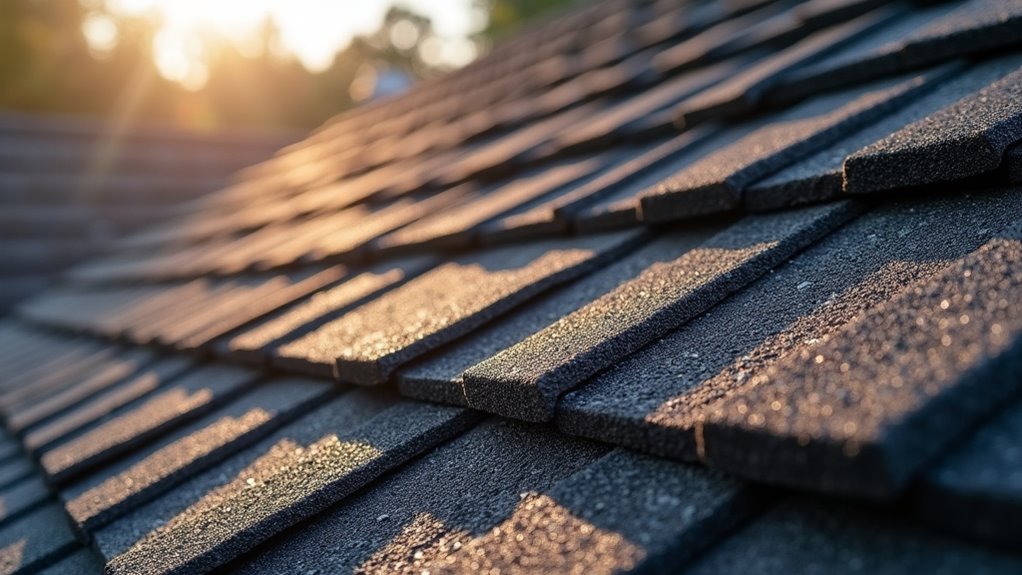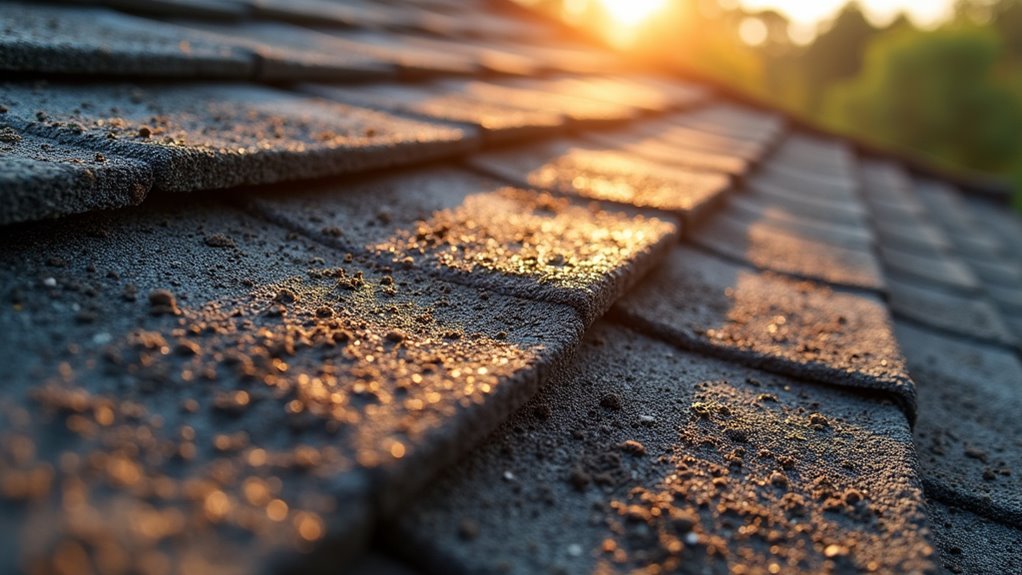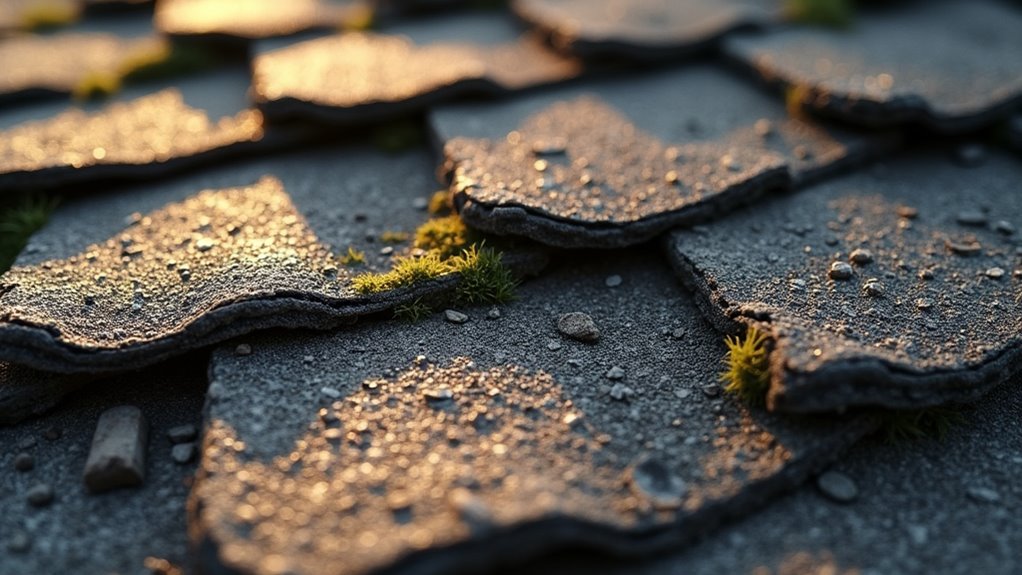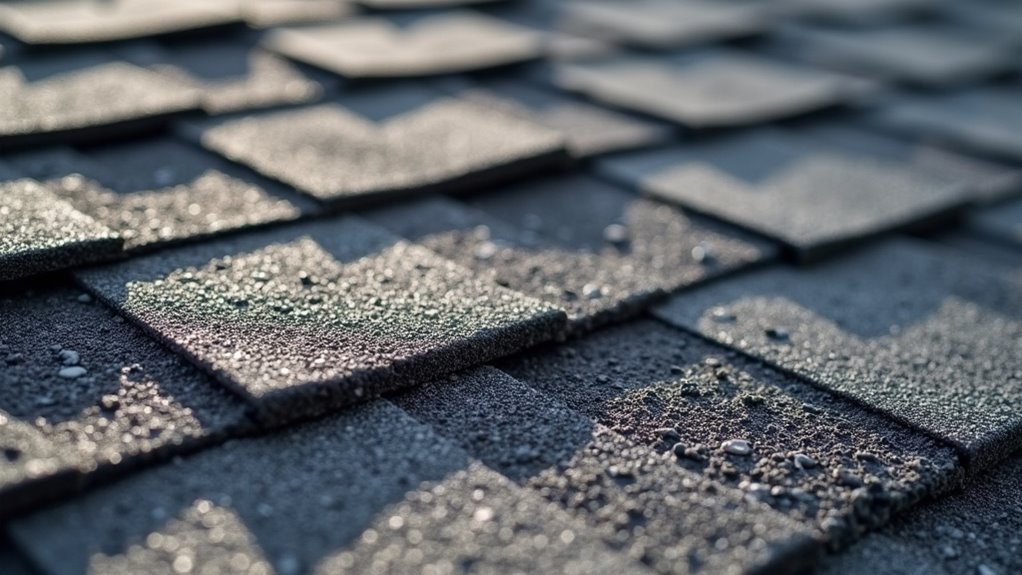Your asphalt shingles’ lifespan varies considerably based on the type you’ve installed. Basic 3-tab shingles last 15-20 years, architectural shingles endure 25-30 years, and premium varieties can protect your home for 30-40 years. Factors like proper installation, regular maintenance, and local climate conditions will impact their durability. You’ll need to evaluate your budget, aesthetic preferences, and performance requirements to determine which grade offers the best long-term value for your situation.
Types of Asphalt Shingles and Their Expected Lifespans

While asphalt shingles remain North America’s most popular roofing material, they’re manufactured in three distinct categories: 3-tab, architectural, and premium. 3-tab shingles typically last 15-20 years and represent the most basic option, while architectural shingles offer 25-30 years of protection with improved dimensional appearance.
Premium shingles, designed to mimic slate or wood shake, can last 30-40 years with proper maintenance. You’ll find that architectural shingles outperform three tab shingles in wind resistance, offering protection up to 130 mph compared to 60 mph for standard 3-tabs. The increased durability comes from their multi-layer construction and higher weight per square. When selecting your shingle type, consider your climate, budget, and aesthetic preferences, as each category offers distinct performance characteristics and warranty coverage.
Key Factors That Impact Shingle Durability

Beyond the inherent qualities of each shingle type, several external factors greatly influence their longevity. Your roof’s slope, local climate conditions, and ventilation system play essential roles in determining how long your shingle materials will last.
Proper installation techniques markedly impact durability. You’ll need correctly placed fasteners, adequate underlayment, and precise alignment to guarantee maximum lifespan. Shingles installed in valleys and high-stress areas require extra attention to prevent premature wear.
Temperature fluctuations, UV exposure, and precipitation levels in your region affect degradation rates. You’ll see faster deterioration in areas with extreme weather shifts or intense sun exposure. Furthermore, nearby tree coverage can introduce moisture retention and organic debris that compromise shingle integrity. Regular maintenance and prompt repairs help mitigate these environmental impacts.
Signs Your Asphalt Shingles Need Replacement

Identifying early warning signs of shingle deterioration will help you prevent extensive roof damage and costly repairs. You’ll need to watch for telltale indicators like curling edges, missing shingles, and significant granule loss that exposes the underlying mat to UV radiation. Dark streaks on your roof’s surface often signal the presence of algae growth and accelerated deterioration of the protective granular coating.
Curling and Missing Shingles
When asphalt shingles begin to curl or go missing, they’re sending clear distress signals that require immediate attention. You’ll notice curling shingles in two distinct patterns: cupping, where edges turn upward, and clawing, where middle sections rise while edges remain flat. Both conditions expose your roof to water infiltration and wind damage.
Missing shingles create vulnerable spots where water can penetrate your roof’s decking. High winds, improper installation, or aging adhesive strips often cause shingles to detach. Even a single missing shingle can compromise your roof’s water-shedding capability, leading to leaks and structural damage. If you spot bare patches or find shingle granules in your gutters, don’t wait – these issues won’t resolve themselves. Contact a qualified roofing contractor to assess the damage and determine if repairs or full replacement is necessary.
Surface Granule Loss
The protective granules coating your asphalt shingles serve as an essential defense against UV rays and weather exposure. When you notice excessive granule shedding in your gutters or at the base of downspouts, it’s a clear indicator that your shingles are deteriorating. This loss of the protective layer greatly reduces your roof’s ability to withstand environmental stressors and accelerates wear.
- Check your gutters during routine cleaning for accumulation of loose granules
- Inspect shingle surfaces for bald spots or areas where the dark asphalt mat is visible
- Look for granules collecting in drainage areas after heavy rainfall
- Examine the color consistency of your roof, as patchy or faded areas indicate granule loss
When granule loss becomes widespread, you’ll need to evaluate roof replacement to maintain your home’s structural integrity.
Visible Dark Streaks
Dark streaks appearing on your asphalt shingles typically indicate the presence of Gloeocapsa magma, a blue-green algae that feeds on the limestone filler within the shingles. While these streaks don’t immediately compromise your roof’s structural integrity, they’ll accelerate shingle deterioration and reduce your home’s curb appeal.
You’ll notice these streaks most prominently on north-facing roof sections where moisture tends to linger. Professional streak removal services can eliminate existing algae growth using specialized cleaning solutions, but without proper prevention methods, the problem will likely recur. Consider installing zinc or copper strips near the roof’s ridge – these metals create an environment inhospitable to algae growth. If your roof shows extensive streaking combined with other wear indicators, it’s time to consult a roofing professional about potential replacement.
Climate and Weather Effects on Shingle Longevity
Climate variations greatly impact your asphalt shingle roof‘s lifespan, with extreme temperatures and weather patterns accelerating wear patterns. In regions experiencing significant climate impact, you’ll notice your shingles might not reach their expected service life. Temperature fluctuations cause expansion and contraction cycles that stress the roofing materials, while severe weather events can inflict immediate damage.
Extreme weather conditions and temperature swings can dramatically shorten your roof’s lifespan through accelerated wear and sudden damage.
- High temperatures above 85°F accelerate granule loss and can cause shingles to become brittle and crack
- Freeze-thaw cycles create ice dams that force water under shingles, leading to deck rot and leaks
- Strong UV exposure in sunny climates degrades the asphalt’s petroleum compounds faster
- Areas with frequent hail, high winds, or heavy rainfall experience more rapid deterioration of protective granules and sealant strips
Proper Installation and Its Role in Shingle Life
Professional installation methods considerably influence your asphalt shingle roof’s durability and performance. The correct nailing pattern, proper overlap, and precise shingle alignment are vital factors that’ll determine how well your roof withstands environmental stresses.
When you’re getting your roof installed, make certain your contractor follows manufacturer-specified installation techniques. These include using the right number of nails per shingle (typically 4-6), maintaining proper exposure levels, and installing adequate underlayment. You’ll also want to verify they’re implementing correct starter strip placement and proper ventilation systems.
The quality of workmanship during installation directly impacts your roof’s resistance to wind uplift, water penetration, and thermal movement. Poor installation practices can reduce your shingles’ life expectancy by up to 30% and potentially void your manufacturer’s warranty.
Essential Maintenance Tips to Extend Shingle Life
Regular maintenance of your asphalt shingle roof can greatly extend its service life and protect your investment. By implementing preventive measures and scheduling routine roof inspections, you’ll identify potential issues before they escalate into costly repairs.
- Perform biannual shingle cleaning to remove debris, moss, and algae that can trap moisture and deteriorate roofing materials
- Schedule professional roof inspections every spring and fall to assess shingle condition, flashing integrity, and proper ventilation
- Trim overhanging tree branches that can scrape against shingles or drop leaves and debris onto your roof
- Clear gutters and downspouts regularly to prevent water backup that can damage shingle edges and underlying roof structure
Remember to document all maintenance activities and keep detailed records of professional inspections to track your roof’s condition over time.
Cost Comparison: Different Grades of Asphalt Shingles
When selecting asphalt shingles for your roof, you’ll encounter three distinct quality grades that greatly impact both initial costs and long-term value. A detailed cost analysis reveals significant price variations between 3-tab, architectural, and premium shingles.
| Grade Type | Cost per Square* | Expected Lifespan |
|---|---|---|
| 3-Tab | $70-90 | 15-20 years |
| Architectural | $100-150 | 20-30 years |
| Premium | $160-220 | 25-40 years |
*One square = 100 square feet
The longevity comparison demonstrates that premium shingles, while requiring a higher upfront investment, often prove more cost-effective over time. They’re engineered with improved durability features like impact resistance and advanced UV protection. You’ll find that architectural shingles offer a superior balance between performance and price, making them increasingly popular among homeowners seeking value-oriented roofing solutions.
Common Problems That Reduce Shingle Lifespan
Several critical factors can greatly reduce the expected lifespan of asphalt shingles, even when they’re rated for decades of service. Your roof’s longevity depends heavily on proper shingle materials and installation techniques, yet common issues can compromise their durability.
- Poor attic ventilation traps heat and moisture, causing shingles to curl, blister, and deteriorate prematurely from the underside
- Improper installation, including incorrect nail placement or inadequate fastening, leads to wind damage and moisture penetration
- Low-quality underlayment or inadequate deck preparation creates an unstable foundation, causing shingles to fail earlier than expected
- Tree damage from overhanging branches and accumulated organic debris retains moisture and promotes algae growth, breaking down shingle materials
These problems accelerate wear and often void manufacturer warranties, considerably shortening your roof’s functional lifespan.
Warranty Considerations for Asphalt Roofing
Understanding your asphalt shingle warranty‘s coverage and limitations proves critical for protecting your roofing investment. Most manufacturers offer two distinct warranty types: a limited lifetime warranty covering manufacturing defects and a shorter-term protection plan for weather-related damage.
You’ll need to carefully review your warranty duration, as coverage typically decreases over time. Many warranties start at 100% coverage for the initial 10 years, then reduce annually. You should note that standard warranty coverage doesn’t include labor costs for replacement or damage from improper installation.
To maintain valid warranty coverage, you’ll need to provide proof of proper installation by certified contractors and regular maintenance documentation. Some manufacturers also require registration within a specific timeframe after installation to activate your full warranty benefits.
Frequently Asked Questions
Can I Install New Asphalt Shingles Over Existing Ones?
While shingle layering (installing new shingles over existing ones) is technically possible, it’s not recommended for ideal roof installation. You’ll face several issues: added weight that can stress your roof structure, inability to inspect and repair underlying damage, reduced shingle lifespan, and potential warranty violations. Most building codes allow a maximum of two layers, but you’re better off removing old shingles initially to guarantee proper installation and maximum durability.
Is It Possible to Paint Asphalt Shingles to Change Their Color?
While you can technically paint asphalt shingles, it’s not recommended by roofing professionals. Standard paint won’t properly adhere to the granulated surface, and even specialized acrylic roof coatings don’t guarantee lasting shingle colors. Painting techniques might temporarily change the appearance, but you’ll likely face issues with peeling, fading, and reduced shingle performance. Instead, consider replacing your shingles with your desired color choice for a proper, long-lasting solution.
How Much Does a Full Asphalt Shingle Roof Weigh?
Your asphalt shingle roof typically weighs between 2.5 to 4 pounds per square foot, meaning a 2,000-square-foot roof can weigh 5,000-8,000 pounds. For roof weight comparison, this is heavier than metal roofing (1-2 pounds/sq ft) but lighter than slate (10 pounds/sq ft). When planning shingle maintenance tips, you’ll need to take into account this substantial weight, especially if you’re adding a second layer of shingles, which can double the load.
Are Asphalt Shingles Recyclable After Removal?
Yes, you can recycle asphalt shingles, which greatly reduces their environmental impact. Shingle recycling facilities process old roofing materials into components used for road construction, new shingles, and cold patch for potholes. However, you’ll need to make sure your shingles are free from non-asphalt materials like nails and wood. Many roofing contractors now partner with recycling centers, making it easier to dispose of your old shingles responsibly.
Can I Walk on My Asphalt Shingle Roof Without Damaging It?
You can walk on asphalt shingles, but proper roof maintenance techniques and safety precautions are essential. Use soft-soled shoes for better grip and avoid walking on your roof during extreme temperatures when shingles are brittle or soft. Step on the flattest parts of shingles where they’re supported by decking underneath, and walk near the roof’s peak where the structure is most stable. Always use proper fall protection equipment.

